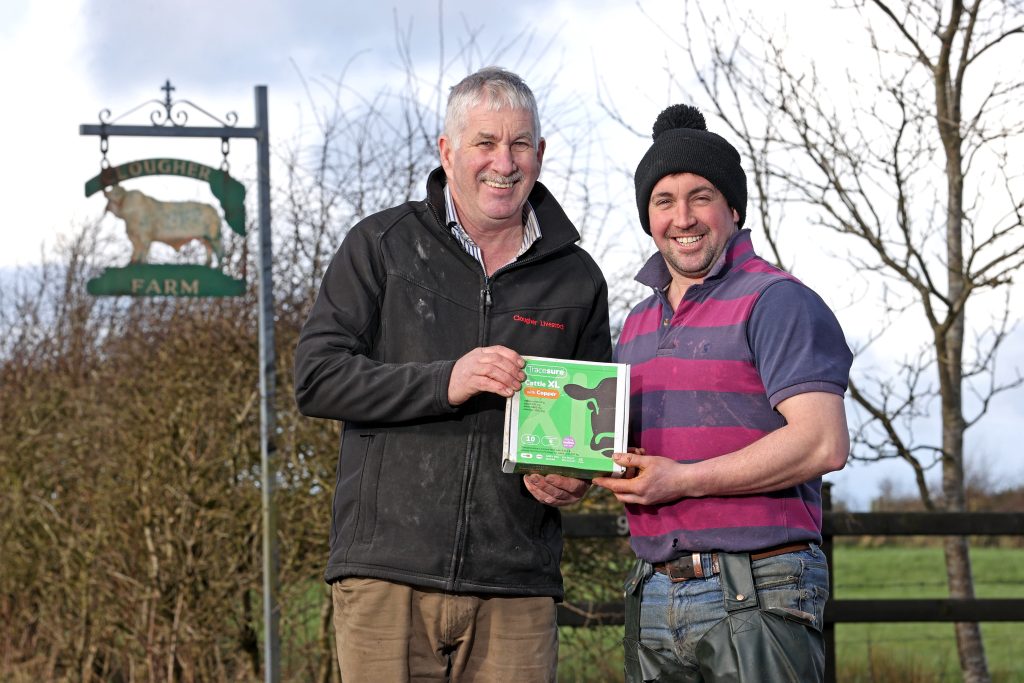Father and son, Victor and Davy Chestnutt, are the sixth generation to run Clougher Farm in Bushmills, County Antrim. And they’ve been using ANIMAX Tracesure for over a decade.
Victor Chestnutt, OBE, is a prominent figure in the agricultural sector in Northern Ireland; having held the roles of Deputy President and then President of the Ulster Farmers’ Union between 2016 and 2022. Before and alongside this, Victor and Davy have built up some highly-reputable pedigrees – Bushmills Charolais, Clougher Aberdeen Angus, Bushmills Texels and Clougher Texels. The Chestnutt’s also milk 170 Holstein cross Montbeliarde cows, all year round, supplying into Aurivo.
“We’re on a marginal hill-type farm here. We’ve all types and quality of soil and know from soil and forage testing that we have a selenium deficiency”, says Victor. “Cows weren’t presenting right at calving, were holding cleanings, and calves had no will to live and suffered with scours. In the winter we feed a TMR with homegrown barley, a balancer and silage. In the summer, the cows graze”.
“We started off with an oral paste that came in a glass syringe, alongside bagged minerals. We found that the paste worked better than the bagged minerals which were a bit of a hassle, so carried on with it for a number of years. But this then went off the market and we could not find an alternative that would give us the same results”.
“So, we went on to using a bolus for a year and had mixed results. Someone said I should try ANIMAX Tracesure, and the cows got back up to the same performance level as with the paste and with none of the previous problems. If we miss doing a cow in the dairy, we can definitely tell as she’ll tend to hold her cleansing or get metritis”, says Victor.
Proactively bolusing with ANIMAX Tracesure
- Milking dairy cows are bolused with ANIMAX Tracesure® Cattle XL at drying-off and pre-winter calving
- Replacement dairy heifers (6+ months) are bolused with ANIMAX Tracesure® Cattle at turn-out
- Charolais and Aberdeen Angus cows are bolused with ANIMAX Tracesure® Cattle XL 8-weeks pre-calving
- Young bulls are bolused with ANIMAX Tracesure® Cattle at turn-out
“We’ve been using ANIMAX Tracesure with copper in our cattle for 10 years or more now, and I am pretty sure that the savings in bagged minerals pays for the bolus. I know the cattle have it in them and that job is done, which is really important when I am often doing other things. I have complete confidence in the product and know it works commercially”, concludes Victor.
How the weather impacts trace elements
All you need to know about ANIMAX Tracesure
‘Proactive bolusing’ is a concept from ANIMAX of ensuring each animal has enough trace elements before the costs of any trace element deficiencies take hold. It has been developed by scientists, vets, and farmers to be precise, effective, and easy.
“By bolusing heifers or cows with ANIMAX Tracesure in the four weeks before turning out, farmers have peace of mind that every heifer and cow is up with what she needs to utilise valuable grass from spring to summer”, explains Dr Berry.
“The ANIMAX Tracesure bolus technologies feature what we call ‘diffusion technology’. This is designed to offer a consistent rate of release to keep animals covered for the 6 month spring/summer/grazing period. It works by allowing the rumen fluid to enter the bolus lodged in the rumen/reticulum, whilst resulting in trace elements to diffuse out. Unlike eroding, dissolving, or oxidising boluses, this means the bolus retains its size and critical density for up to 6 months, regulating the rate of release and reducing the risk of premature passing”.
“A recent advancement to our range is the ‘waxed-groove’ feature. Our boluses are coated with a beeswax, providing a partial barrier that further regulate release. The outer wax starts to wear off within the first day of the bolus being administered into the reticulum, beginning the process of trace element release. The wax remains in the grooves up to 12 weeks to further ensure a consistent and safe release”, adds Dr Berry.
“The need for precision supplementation stems from the fact that these trace elements are so ‘micro’ and required in such small quantities. For example, a small sachet of salt that you’d find in the average café contains the equivalent volume of selenium that to supply 180 cows for one day”, advises Dr Berry.
“While energy, protein, water, and macrominerals (such as calcium required to reduce the risk of low blood calcium at calving) are essential nutritional factors to get right, trace elements are next on the list with regards to achieving performance from an animal, along with infections and parasites”, concludes Dr Berry.


